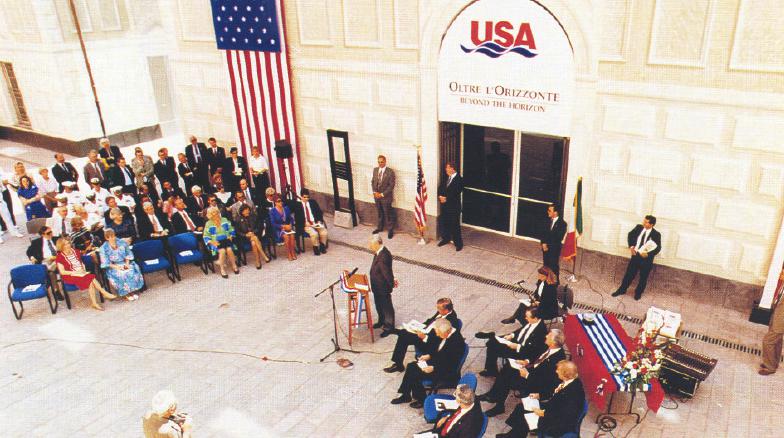This article, originally published in June 2014, is part of “Tales from the Expo,” an InPark Magazine online book written by James Ogul and edited by Judith Rubin.
[dropcap color=”#888″ type=”square”]S[/dropcap]ince retiring from the US State Dept in 2011 after a 30+ year career in world expos, Ogul has remained on the scene in an advisory and consulting role. Previous stories covered Tsukuba ’85, Vancouver ’86 and Brisbane ’88, and Knoxville ’82 and New Orleans ’84; next story to look at Taejon ’93, Lisbon ’98 and Hanover 2000 (ultimately, the US did not participate in Hanover). Here, Ogul’s report shows how, in trying conditions, resourcefulness helped maintain a US presence at two world’s fairs in 1992.
Featured image above: Opening ceremony for the US Pavilion at the Colombo 92 world exposition in Genoa, Italy. Photo courtesy James Ogul.
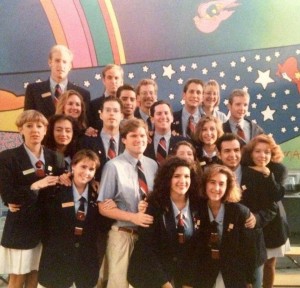
How did we get two world expos in 1992?
We nearly had three – originally Chicago and Seville were to have twin Universal expos in addition to Genoa’s smaller event. You can read about the BIE (Bureau of International Expositions) taking steps to reduce the frequency of expos in my previous article. The process took some time to ratify among the BIE member states. Meanwhile, both Seville and Genoa had a special case to make for historical tie-ins to 1992.
The Universal Exposition of Seville 1992 commemorated the 500th anniversary of Columbus’s voyage to the New World and had as its theme “The Age of Discovery.” This six-month event, classified as a Universal expo, ran April 20-October 12, 1992, closing on Columbus Day. Attendance was over 40 million. Spain invested over $4 billion in the expo and related infrastructure. At the time it was said to be the largest construction project in the world. 110 countries participated on the 530-acre site located on an island in the Guadalquivir River across from central Seville.
Genoa ’92 likewise marked the 500 years since Columbus, a Genoese, sailed to find the New World. The theme was “Christopher Columbus, The Ship and the Sea.” It ran May 15-August 15, 1992 – a three-month, specialized expo.
What the BIE, the Paris-based organization that sanctions such events, used to categorize as Universal and Specialized expos are now known as Registered and Recognized.
The New World and the “new world order”
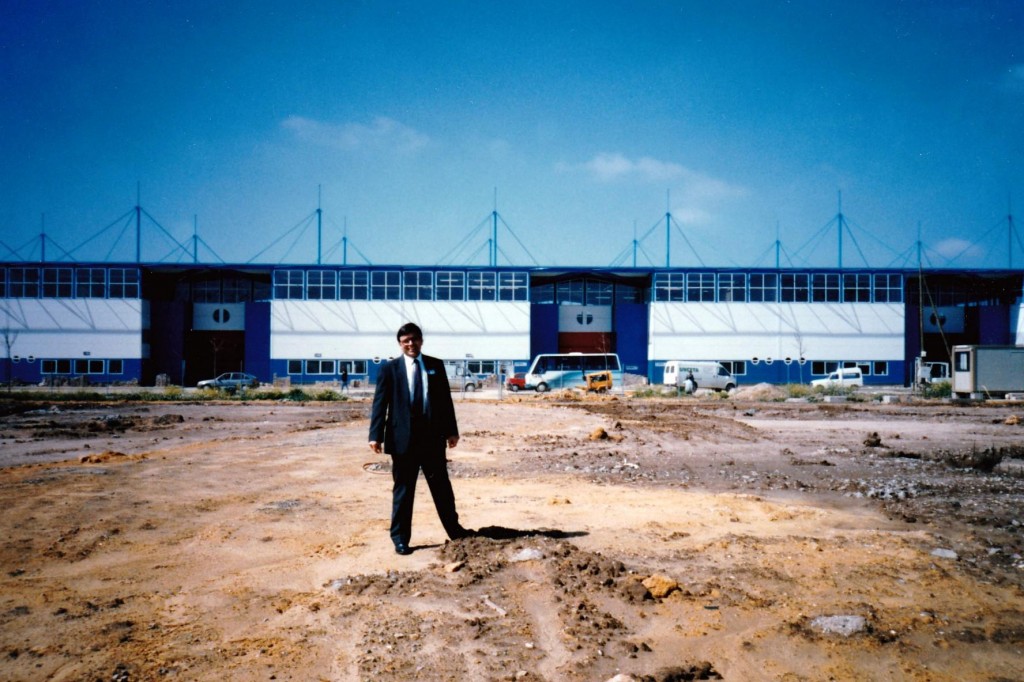
[dropcap color=”#888″ type=”square”]T[/dropcap]here were a lot of things going on in the world in the run-up to the 1992 world’s fairs in Seville, Spain, and Genoa, Italy. The Berlin Wall came down in 1989 and the Gulf War took place in 1990-91. Chicago had planned on hosting a world’s fair at the same time as Seville and then had to pull out due to financial problems. But even with Chicago dropping out there were still two world’s fairs in 1992. And Seville’s expo wasn’t the only major international event taking place in Spain in 1992 – the Barcelona Summer Olympic Games were in fact much more visible on the world stage. The Olympics in particular affected private sector fundraising for the US pavilion at Seville. The United States Information Agency (USIA) was responsible for our country’s presence at both Seville and Genoa. I was asked to serve as project director for the US pavilion at Seville. As a result, my Seville story here is considerably more detailed than my Genoa recap.
Why the US took part despite challenges
Mounting an expo pavilion is a challenge at any time and the challenge was multiplied for the US in 1992, for reasons cited above. Nevertheless the US did commit to exhibiting at both expos and made good on the commitment.
The objectives governing US participation at Seville Expo 92 and Colombo 92 echo the general objectives and reasons for participating in any world exposition:
–To demonstrate US support for an important ally and friend by active participation at the Expo.
–To present (even within tight budgetary restrictions) an exhibit that would entertain visitors, yet also convey a meaningful message.
These objectives were achieved at Seville and at Genoa. The collaboration between the private and public sectors functioned effectively and resulted exhibits that to all indications, impressed the majority of those who saw them and ensured that the United States had a meaningful presence at an event of global significance.
SEVILLE: FINDING THE MONEY
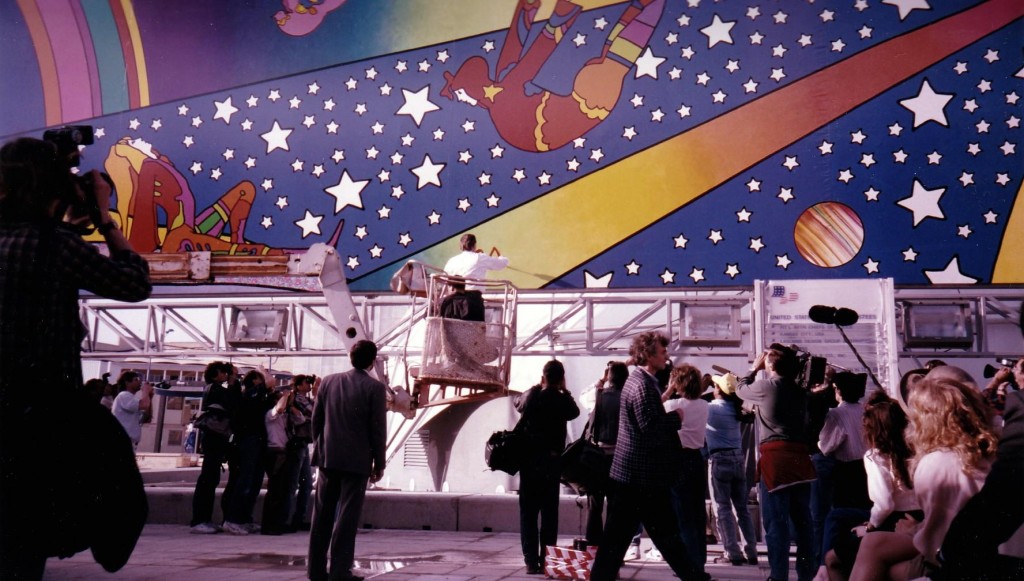
[dropcap color=”#888″ type=”square”]S[/dropcap]eville ’92 being a Universal expo meant, among other things, that each country had to build its own pavilion structure (in the lesser category 3-month world’s fairs, pavilion space is provided by the organizers). US participation at Seville was initiated by a verbal agreement made to King Juan Carlos by President Reagan on the occasion of a White House visit. The President then sent a directive to the Commerce Department, the State Department and the USIA asking them to equitably share the cost. (In the final analysis USIA carried almost the entire burden.) The President further stated that the project was to have 50/50 government/private sector funding. USIA launched an unprecedented fundraising effort, which raised $4,972,248 in cash donations and $11,314,758 in in-kind donations. Obtaining funding from Congress for Seville and Genoa was a protracted ordeal and in the final analysis both projects were funded through reprogramming – that is, Congress authorized USIA to fund them by taking money from other projects. The bottom line is there was no new money for them. The total amount of Federal money was $20,626,000.
VIDEO: James Ogul gives actress Barbara Eden (“I Dream of Jeannie”) a tour of the US Pavilion at Seville Expo 92. Video courtesy James Ogul.
The pavilion design trajectory
The USIA conducted an architectural completion for a US Pavilion at Seville and Barton Myers and Associates, based in Los Angeles, was awarded the contract. Unfortunately due to budget issues the original Barton Myers design could not be built and most of it was replaced with two geodesic domes that USIA had previously used in the Soviet Union.
Although the US was invited to participate in Seville Expo 92 in 1986, a decision to do so was not made until 1988. Congressional approval to reprogram funds for the project did not occur until two years later, in 1990, leaving little time to raise the $15 million required in private sector matching funds and to design and build the original pavilion design. Although fundraising goals were eventually met, project costs were driven up as a consequence of the late start.
The subsequent abandoning of most of the original architectural design and substitution of two geodesic domes for part of the pavilion were not well received by the media, which routinely criticized the US for its architecture. [note from IPM co-editor Judith Rubin: I was on staff at World’s Fair magazine at the time. Here is an excerpt from our story of April 1991, titled “US Guts Pavilion, Goes Geodesic” by Alfred Heller: “Everybody in what remains of the world’s-fair bureaucracy in Washington denies the United States Pavilion at Expo 92 is a war casualty, but it is – certainly of the Persian Gulf expedition… The pavilion however, was not killed in action. It survives. But it was hit. There’s still pain, and the victim is disoriented…”]
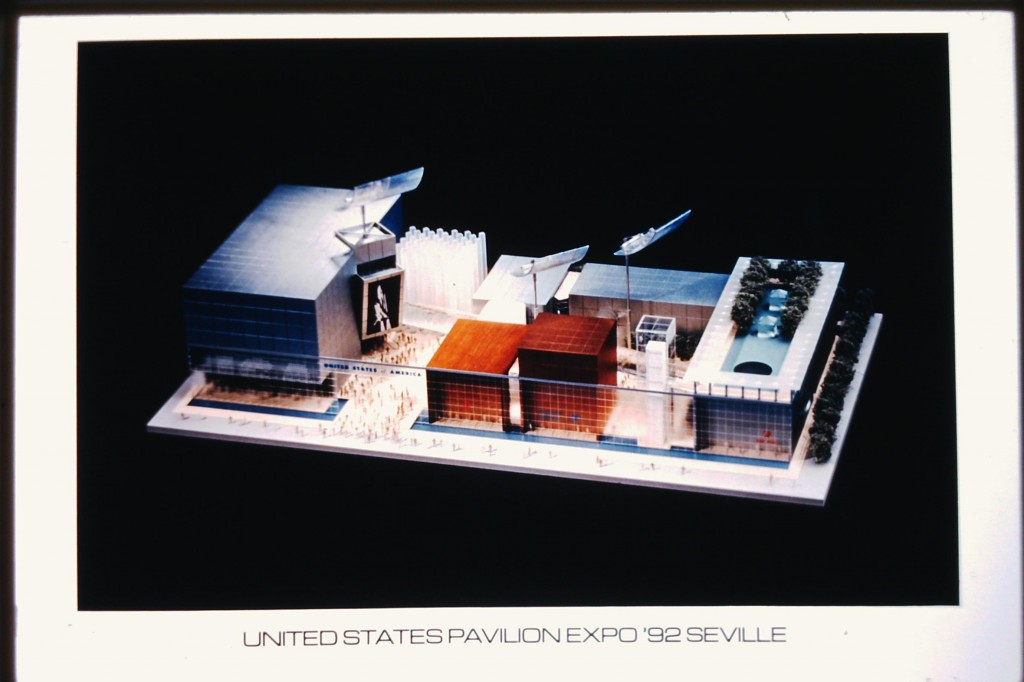
The theme of the US Pavilion was “Life, Liberty and the Pursuit of Happiness.” It had 44,000 square feet of covered space on a two-acre site. It was laid out campus style with multiple buildings and large outdoor courtyards. Buildings included the two geodesic domes, each measuring 10,000 square feet. One dome housed the 600-seat World Song Theater and the other housed an exhibit on the US Bill of Rights, which contained Connecticut’s ratification copy. There was also a two-story, rectangular building of 20,000 square feet. This structure had offices and Commissioner General’s lounge, sponsored by Coca-Cola, on the upper floor and corporate exhibits, a restaurant and a gift shop on the lower level.
Also on the pavilion grounds were a walk-through “American Spirit” home, provided by the American Plywood Association, measuring 3,000 square feet, a performance stage/dressing room structure measuring 1,000 square feet, an exhibit of experimental automobiles provided by General Motors, and a 70-foot by 30-foot outdoor sports court. There were two 153-foot-long by 30-feet-high murals by artist Peter Max, depicting America’s past 500 years and next 500 years. Three giant sails representing the red, white and blue pavilion logo were mounted on towers 90 feet above the pavilion.
A wall of cascading water 460 feet long and 40 feet high fronted the pavilion. Visitors passed through a 60 by 30 high opening in the water wall to enter the central courtyard with its sports court and stage. Continuous outdoor sports and cultural entertainment involving 4,500 American performers and athletes took place over the fair’s six-month run. Performances the the Harlem Boys Choir, Ballet Hispanico and hundreds of other groups represented the diversity of America to thousands of pavilion visitors.
Inside the domes
The Peter Max murals flanked the courtyard and behind them were the geodesic domes. The dome to the right of the courtyard was a 600-seat theater showing “World Song,” a 12-minute, 70mm film sponsored by General Motors and shown on a 20-foot by 40-foot screen. Produced by Bob Rogers a two-time Academy Award nominee and founder of BRC Imagination Arts, ‘World Song” conveyed the simple idea that the human life cycle is universal regardless of nationality, culture, religion or race. It was given a five star rating at the expo. The show ran three times an hour. Boston Light and Sound put together the AV system and and operated the theater.
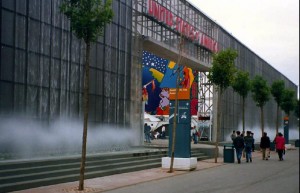
The dome to the left of the courtyard housed “Where Liberty Dwells, There is my Country.” This exhibit was sponsored by American international Group, Xerox and the Commission on the Bicentennial of the United States Constitution. It was produced by Staples and Charles, Ltd. and it opened with an award-winning video featured an international group of “witnesses to freedom” who related how the Bill of Rights had affected their lives. The witnesses included retired Chief Justice of the U.S. Supreme Court Warren E. Burger, Coretta Scott King, Spanish Prime Minister Felipe Gonzalez, Nicaraguan President Violeta Barios de Chamorro, Chief Wilma Mankiller of the Cherokee Nation, French intellectual Jean-Francois Revel, Czechoslovakian Ambassador to the United States Rita Klimova and Bulgarian Parliament Secretary Emilia Drumova. Past the video, visitors were able to view Connecticut’s original ratification copy of Bill of Rights, displayed with support exhibits that put the first 10 amendments into historical context and illustrated their realization in events that have changed the world in recent years. I remember that one of our first visitors was Polish President Lech Walesa who came expressly to see the Bill of Rights.
Other exhibits, and retail
Adjacent to the dome with the Bill of Rights exhibit, the 3000-square foot, “Spirit of America“ home showcased the use of factory crafted. structural wood components and electronic climate control. Visitors were given conducted tours though the home by staff representing the sponsor, American Plywood Association. I also took a few dignitaries though the home, my favorite being actress Barbara Eden who was emcee along with actor Tony Randall for our National Day Ceremony.
Rounding out the exhibitions were GM’s outdoor exhibit of futuristic cars and a 2,000 square foot exhibit featuring Kansas City (sister city of Seville) and exhibits by the US Mint (which also operated a gift shop), DHL, Sprint international, and Ameritech. Contractor-operated concessions including the All American Sport Shop, Yankee Stadium restaurant, and Baskin-Robbins.
Corporate equations
A multi-year fundraising effort resulted in $4,972,248 million in cash contributions and $11,314,758 million in in-kind support raised from 55 private sector sponsors. Most of our staff was involved in fundraising. The highlight of my own personal fundraising experience was a $1 million check from Coca-Cola for VIP lounge sponsorship. I vividly remember pulling that check out of its envelope!
We innovated in many ways to supplement federal funding for Seville. One of the more interesting angles: we approached the International Association of Chiefs of Police and worked out an arrangement wherein they would donate the services of State Troopers from around the country to serve as pavilion guards – particularly to protect the ratification copy of the Bill of Rights. The agreement called for the troopers to wear their state uniforms. Our visitors loved having their pictures taken with them and the troopers greatly enjoyed their Seville experience.
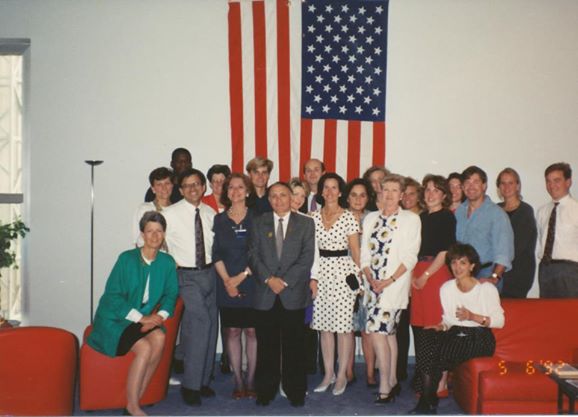
Each corporate exhibitor paid rent for space. We took the total budget and divided by the total exhibit square footage to arrive at a cost per square foot. Sprint paid a sponsorship fee and also installed a teleconferencing center in the pavilion staffed by one of their people. This was made available for a fee to other pavilions for their use. Continental Airlines not only provided complimentary airline tickets but also provided for the return trip of Connecticut’s ratification copy of the Bill of Rights.
When our Commissioner General, Fred Bush, and I visited GM in Detroit regarding sponsorship of the pavilion’s feature film, we negotiated a unique arrangement whereby instead of GM giving us money, they contracted for the film and provided it as an in-kind donation. GM also loaned 25 cars for use by pavilion staff. Coca-Cola not only contributed $1 million but also designed, built and staffed the VIP lounge for an addition budget offset. The American Plywood Association not only paid rent for the space where the American Spirit Home was located, but also paid for the home itself and its design and construction and provided staffing for it. In addition the home was presold and so had a residual use after the expo.
Sealand donated shipping in a special climate controlled container for Connecticut’s ratification copy of the Bill of Rights. They also donated shipping for other exhibit items. We negotiated with the US Mint to operate its gift shop – the Mint paid rent for the space plus a percentage of sales. US Mint gift items were also donated to use as VIP gifts for visiting dignitaries.
Defense Department
I got the idea of soliciting involvement from the US military installations in Spain. I drafted a letter to then Secretary of Defense, Dick Cheney. His response was to offer support, which resulted in a range of assistance. The US Department of Defense played a role in the development, construction and running of the pavilion buildings and mechanical equipment. It also provided logistical and personnel support from the American bases in Spain. The US Navy was enlisted as pavilion construction manager. It took responsibility for design development, cost control and construction oversight. The Department of Defense’s Office of Special Events provided logistics support from the US naval base in Rota and the US Air Force Base in Morón (Andalusia). A team of Sea Bees was detailed to assemble the Bill of Rights exhibit, and provided logistical and material support the US National Day. The Morón Air Base gave logistics assistance and made housing available for security personnel and cultural and athletic groups performing at the pavilion. Last but not least, DOD provided medical support for the pavilion staff, which ultimately saved my life when I had a medical emergency on site.
In spite of its architecture and design issues, with overall attendance of 2.4 million, the US Pavilion at Seville Expo 92 compared favorably with other major participants in terms of audience draw. The feature film for the Bill of Rights exhibit, “Where Liberty Dwells, There is My Country,” won a gold medal at the 1993 International Film and Television Festival in New York. And the pavilion received an unprecedented level of non-federal support. Born of necessity, the fundraising effort brought over $16 million in direct cash and in-kind contributions to the US Pavilion from 55 corporations and civic organizations.
GENOA: COLOMBO 92
[dropcap color=”#888″ type=”square”]C[/dropcap]olombo 92, in Genoa, Italy, was developed on a 12-acre site, renovating the port sector of the city, a location appropriate to the theme of “Christopher Columbus: Ships and the Sea.” Renowned Pritzker awarded “starchitect” Renzo Piano, a native of Genoa, was commissioned to provide the design for the fair.
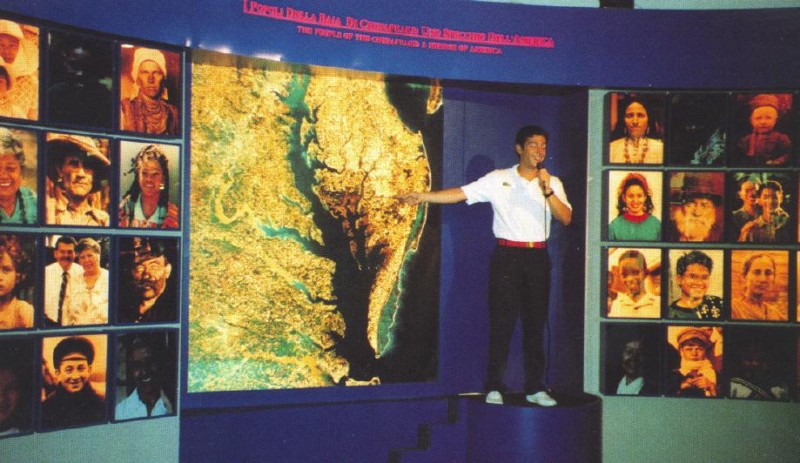
Along with the United States, 52 countries and organizations participated in the Exposition. The final count of visitors to the fair was just under one million. Dignitaries visiting the Genoa expo included the President and the Prime Minister of Italy, the Presidents of Portugal and Honduras: Mrs. Marilyn Quayle, wife of the US Vice-President (she was guest of honor on May 18, the US National Day), Governor William Donald Schaefer of Maryland, the Duke of Kent; Princess Elena of Spain, and Prince Rainier of Monaco.
Federal funding for the US pavilion at Genoa was $1,845,586 in reprogrammed funds from the United States Information Agency. There were six private sector sponsors contributing $1,075,634 for a total project budget of $2,921,220. Amway Corporation was the largest donor at $500,000.
Chesapeake Bay
The United States exhibit was housed in a renovated 17th-century palazzo on the fair site, San Desiderio. Inside, a 5,000 square-foot exhibit on the ground floor made use of multi-media effects in three galleries. The Chesapeake Bay and the port of Baltimore, a sister city to Genoa, were singled out as illustrative of America’s maritime culture. The exhibit carried an environmental message: the importance of looking beyond the horizon to ensure the preservation and protection of the world’s waterways. Oceans are a recurring theme for world expos – most recently seen at Yeosu Expo 2012 in Korea.
In the first gallery of the US pavilion at Colombo 92, a multi-screen slide presentation provided a glimpse of an earlier pristine America, depicting the landscape as it likely appeared when the navigators and explorers first arrived, and of how a nation developed alongside those waterways.
The second gallery concentrated on the Chesapeake Bay and the port of Baltimore. The photographs and videos displayed were designed to give a sense of the people who inhabit the region, of how they use the waters for both work and play, and of their stake in the preservation of the Bay. This was complemented by wooden hand carvings of the Bay’s aquatic life.
The exhibit‘s environmental message was emphasized in a then state-of-the-art, 20-monitor videowall presentation in the third and final gallery. The Planning, Research and Design (PRD] Group. Ltd. of Fairfax, Virginia. had been selected through a national competition to design and develop the US exhibit for Genoa. The content was created by the firm of Hillman and Carr. Inc. of Washington D.C. The installation of the exhibit in Genoa was undertaken by Guidi SRL. Legnano (Milan).
Favorable ratings
Over the three-month run of Colombo 92, 190,076 people visited the US Pavilion. The general public’s response to it was upbeat, as reflected in an informal poll of 609 visitors. A written questionnaire, in Italian and English, revealed that the overwhelming majority (87 percent) judged the exhibit as good or excellent. The videowall presentation in the final gallery was rated as the best feature. And the guides received considerable praise.
Jay Van Andel, Chairman of Amway Corp., was selected as Commissioner General for the US Pavilion in Genoa by President Bush and then USIA Director Bruce Gelb. He was accorded the personal rank of Ambassador by the President for the length of the fair.


